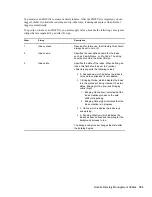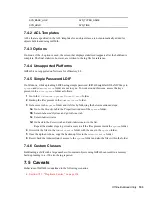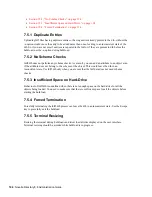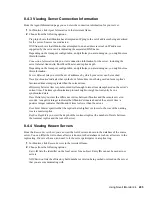
Offline Bulkload Utility
191
n
ov
do
cx (e
n)
22
Ju
n
e 20
09
TIP:
You can temporarily suspend the bulkload by pressing the s/S key. The Escape key(Esc) can
be used to stop the bulkload.
7.2 Multiple Instances
ldif2dib can be used to bulkload entries from LDIF files to a particular instance of eDirectory (DIB)
by specifying the location of its nds.db file with the -n option. If the location of the
nds.db
file is
not specified with the
-n
option and if there is a single instance of eDirectory configured on the
system, ldif2dib automatically detects the location of its database files. However, if there are
multiple instances, ldif2dib displays a menu listing all configured instances and allows you to
choose an instance for bulkload.
For more information on the multiple instances of eDirectory, see
Multiple Instances (http://
www.novell.com/documentation/edir88/edir88new/data/bqebx8t.html)
section in the
Novell
eDirectory 8.8 What’s New Guide
.
7.3 Tuning ldif2dib
This section contains information about the parameters that can be used to tune ldif2dib.
Section 7.3.1, “Tuning the Cache,” on page 191
Section 7.3.2, “Transaction Size,” on page 191
Section 7.3.3, “Index,” on page 192
Section 7.3.4, “Block Cache Percent,” on page 192
Section 7.3.5, “Check Point Interval,” on page 192
7.3.1 Tuning the Cache
The database cache setting is one of the more significant settings that affects the eDirectory
performance. If it is set too low, eDirectory operations slow down because information must be
retrieved from the disk more often. If it is set too high, enough memory is not available for other
processes to run and the whole system slows down. For more information on cache, see
Tuning the
Cache Subsystem (http://www.novell.com/collateral/4621373/4621373.pdf)
in the
Novell
eDirectory 8.8 Performance and Tuning Guide.
Bulkload performance generally increases on increasing the cache size. However, no performance
improvement has been observed by increasing the cache size beyond a value which is 3.8 times the
size of the LDIF file.
7.3.2 Transaction Size
The transaction size defines the chunk size in terms of number of objects per transaction. When the
transaction size is high, a small number of large chunk writes result and when it is low, a large
number of small chunk writes result.
Summary of Contents for EDIRECTORY 8.8 SP5
Page 4: ...4 Novell eDirectory 8 8 Administration Guide novdocx en 22 June 2009...
Page 72: ...72 Novell eDirectory 8 8 Administration Guide novdocx en 22 June 2009...
Page 118: ...118 Novell eDirectory 8 8 Administration Guide novdocx en 22 June 2009...
Page 130: ...130 Novell eDirectory 8 8 Administration Guide novdocx en 22 June 2009...
Page 188: ...188 Novell eDirectory 8 8 Administration Guide novdocx en 22 June 2009...
Page 222: ...222 Novell eDirectory 8 8 Administration Guide novdocx en 22 June 2009...
Page 240: ...240 Novell eDirectory 8 8 Administration Guide novdocx en 22 June 2009...
Page 264: ...264 Novell eDirectory 8 8 Administration Guide novdocx en 22 June 2009...
Page 290: ...290 Novell eDirectory 8 8 Administration Guide novdocx en 22 June 2009...
Page 322: ...322 Novell eDirectory 8 8 Administration Guide novdocx en 22 June 2009...
Page 540: ...540 Novell eDirectory 8 8 Administration Guide novdocx en 22 June 2009...
Page 548: ...548 Novell eDirectory 8 8 Administration Guide novdocx en 22 June 2009...
Page 616: ...616 Novell eDirectory 8 8 Administration Guide novdocx en 22 June 2009...
















































